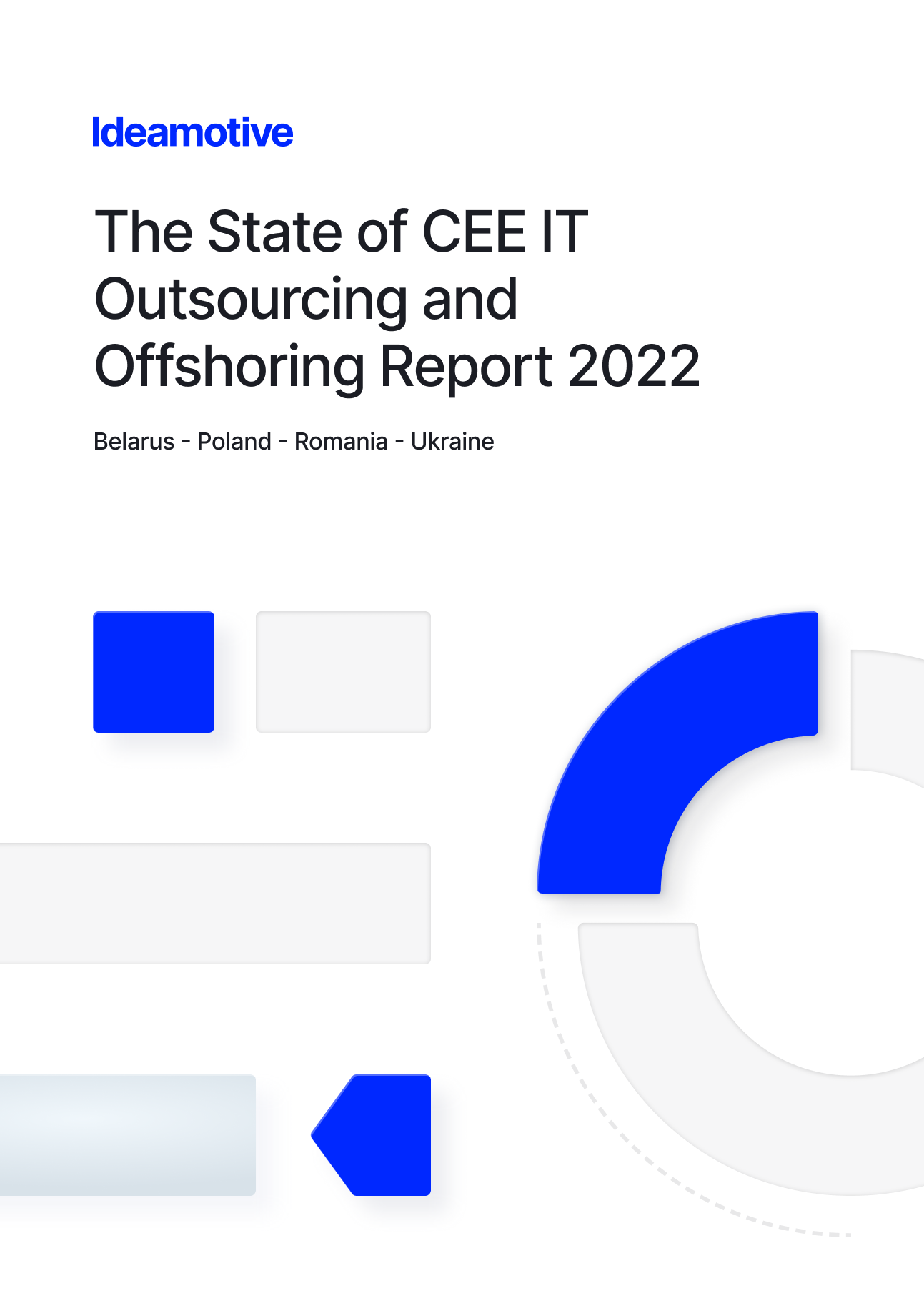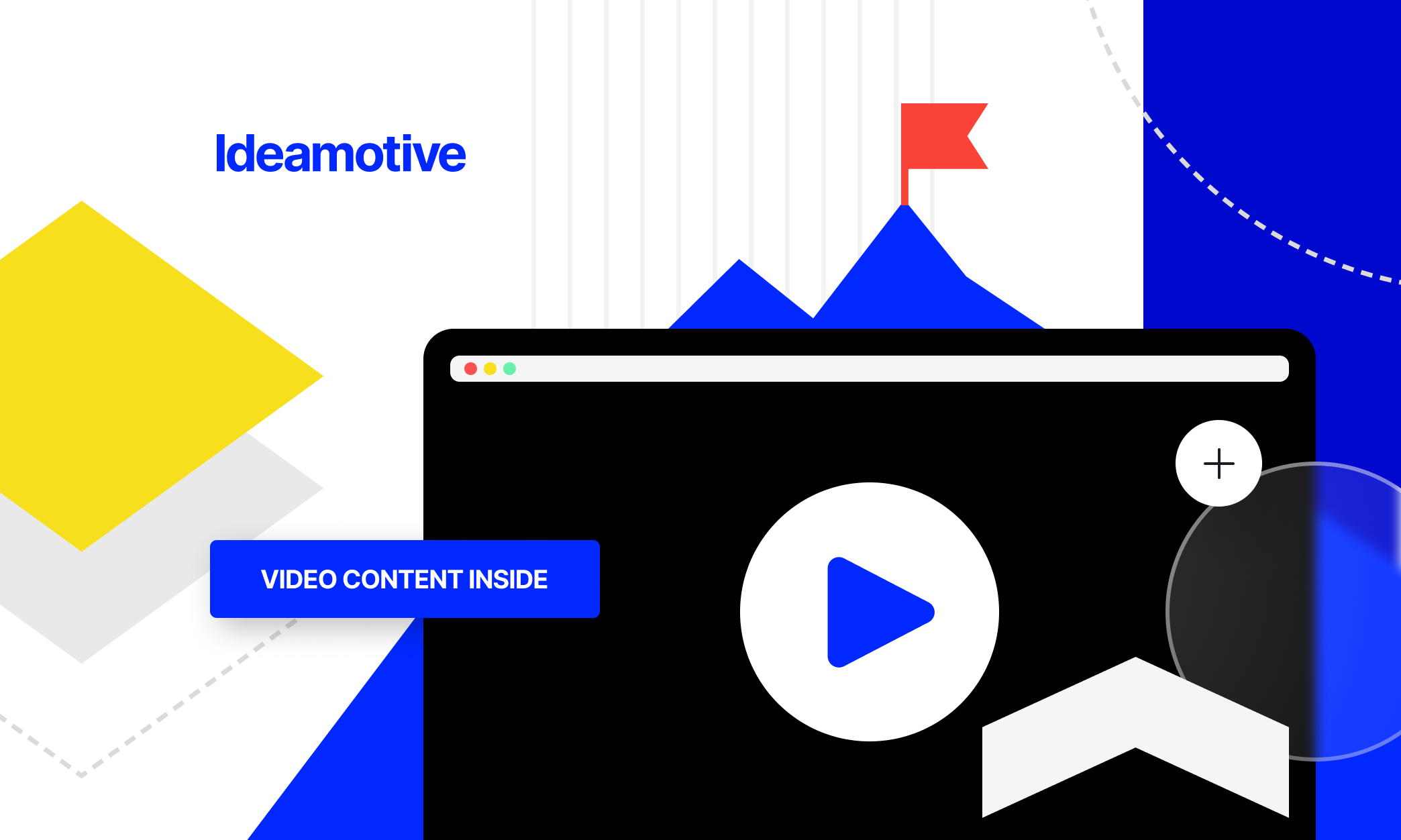A product backlog is the most important artifact in any product development company. How should we structure this critical document? Agree, for founders, product managers, and product owners (who are often the same person), building a workable backlog from your strategic vision can seem almost impossible.
That’s why it is crucial for them to have a well-structured product backlog template before eyes. This minor (at first glance) thing can lead to greater results in the future.
Therefore, we offer you to look at several examples of product backlogs. Also, let’s remember each agile backlog template should answer the following question "How can this template help us move development in the right direction?". In doing so, picking the best-suited one would be 100x more productive.
Let’s go!
What is a product backlog template?
A product backlog is a list of product development activities that is used by product teams to plan, prioritize, and manage tasks. In turn, a product backlog template is a list of all potential features that will be implemented during the course of the project. It is prioritized in terms of business value and is maintained and updated throughout the project. This is the single source of work for the project team and is used to plan the work to be done in each iteration.
Development teams often juggle many products at the same time. A product backlog is a project management tool that helps teams track projects as they are created and iterated. Top-priority tasks are at the top of the product backlog, so teams know what to work on first.
Product backlogs make it easier for teams to plan and allocate resources, and provide a single source of trusted information for everyone to know what development teams are working on. At the same time, backlogs help developers manage the expectations of stakeholders and coordinate their actions.
A product backlog template is a tool often used for agile planning and sprint planning that allows you to store all ideas, plan epics and prioritize tasks. You can put all your ideas and tasks into a product backlog template from any device and be sure that they are all in one place.
Why should you have a product backlog?
Product backlog management is an important task in any product development lifecycle. As products improve and evolve over time, maintaining this prioritized list of product requirements can become a big task if not done correctly. With a product backlog template, you can effectively track your product backlog and plan your sprints more efficiently.
A product backlog is not just a list of new features that need to be built into a product, but also, in essence, a consolidation of feedback about a product from all sources - be it users, a development team, or even the sales and marketing department. And that is why product backlog management is vital. By using a well-structured project management templates, the product manager can track the backlog in the most efficient way.
Benefits of Scrum project backlog template
In a product development scenario, it's easy to overlook upcoming features if the product backlog isn't managed, monitored, and improved on an ongoing basis. With the rich features of a product backlog template, you can do this and more.
Backlog prioritization
With a number of elements in a list without a defined pattern, the list can become cluttered and useless. The templates listed below make it easier to apply a backlog prioritization to your doc. Make it easier for the team to focus on building the best product!
Setting
A product backlog contains all sorts of product changes - new features, updated features, user feedback, bugs, technology updates, etc. With the customization provided by our product backlog templates, all of this can be better managed by customizing the template with dedicated task types and fields to track user feedback and ideas.
Integrated process
Keeping track of backlogs can become cumbersome if backlogs are scattered across lists. Tracking and managing backlogs just got a whole lot easier with the unified workspace provided by our examples of a product backlog. The seamless integration of the product backlog with the sprint planning and release management process allows you to leverage the capabilities of the team.
Multiple views for easy understanding
The product backlog template provides various views that can be effectively used to manage a product backlog. You can view the backlog as a simple list of tasks or as a detailed table with various details such as category, effort, priority, and status by backlog item. You can also view it as a board, which is an intuitive view for understanding the different stages that backlog items are in.
Custom fields
Custom fields such as "Category" and "Effort" can be added to describe the backlog items in more detail. This is especially helpful for the product manager and the team when planning a sprint.
Status tracking
The backlog is effective when it is constantly improved and updated to be the single authoritative source of product requirements. This is only possible if there are different statuses to ensure that tasks are segmented and corrected. Our product backlog templates provide various statuses - New, Pending, In Progress, Under Review, Suspended, Closed, Canceled - that are always at hand to keep track of backlog items.
Best product backlog templates for startups
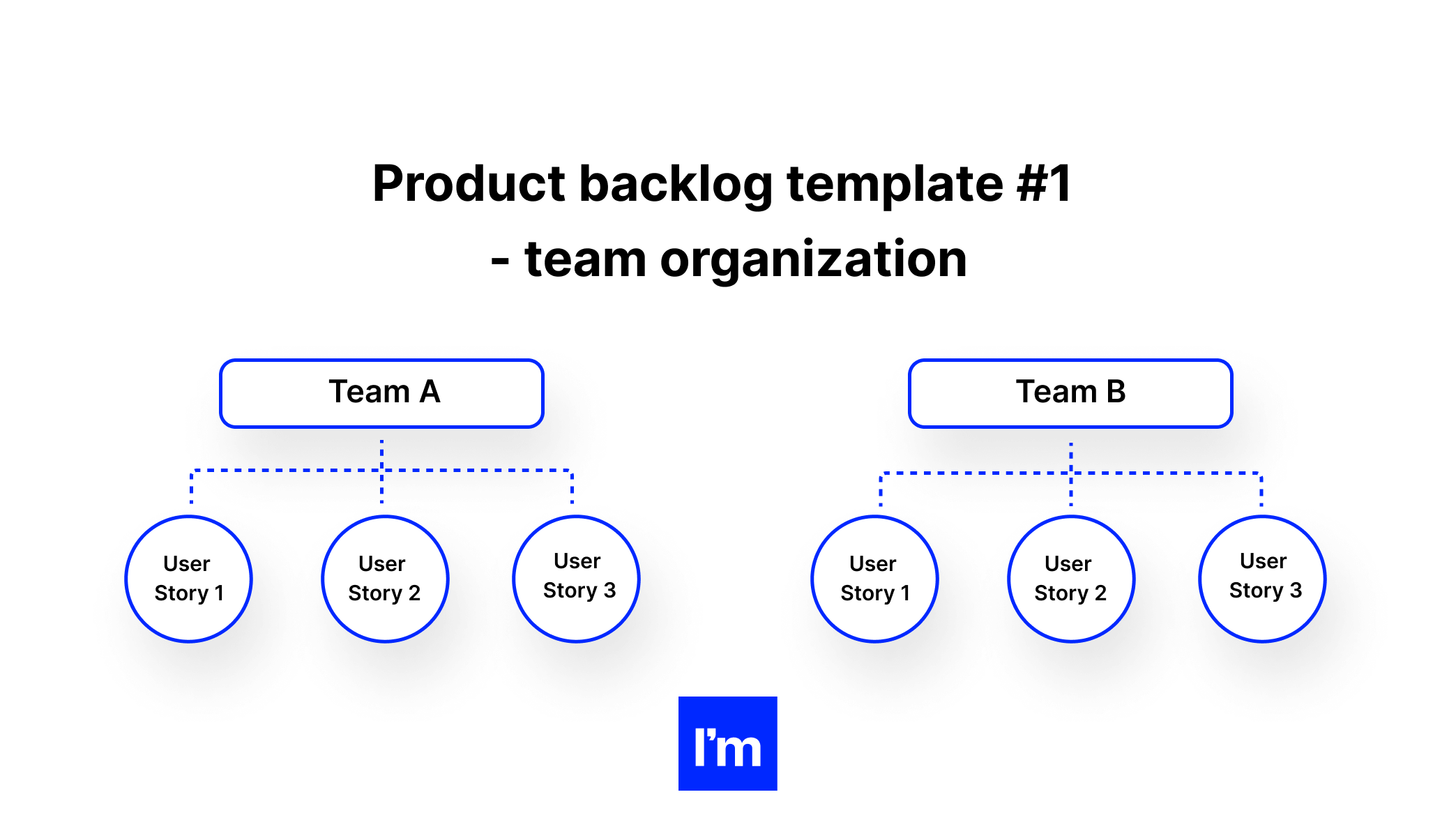
A backlog structured around a team organization does just that: its hierarchy is shaped by the form of the organization—the different teams working on the product. For example Team A, Team B, Team C, or Team Yellow and Blue as in the pic.
When the product owner structures in this way, several things happen:
Teams can resolve dependencies
When they can see their work-in-progress next to each other, teams with heavy reliance on each other suddenly get some visibility they didn't have before. This arrangement greatly simplifies communication and dependency resolution.
User story backlog template can lose context
What happens when we organize a team is that the user stories lose their connection to the overall goals or strategy. One workaround is to supplement this method by heavily using release tags for goal setting.
Products can take on new forms
It has been studied and proven. For better or worse, products themselves tend to take on characteristics of the organizational structures that create them. See Conway's Law and its many implications.
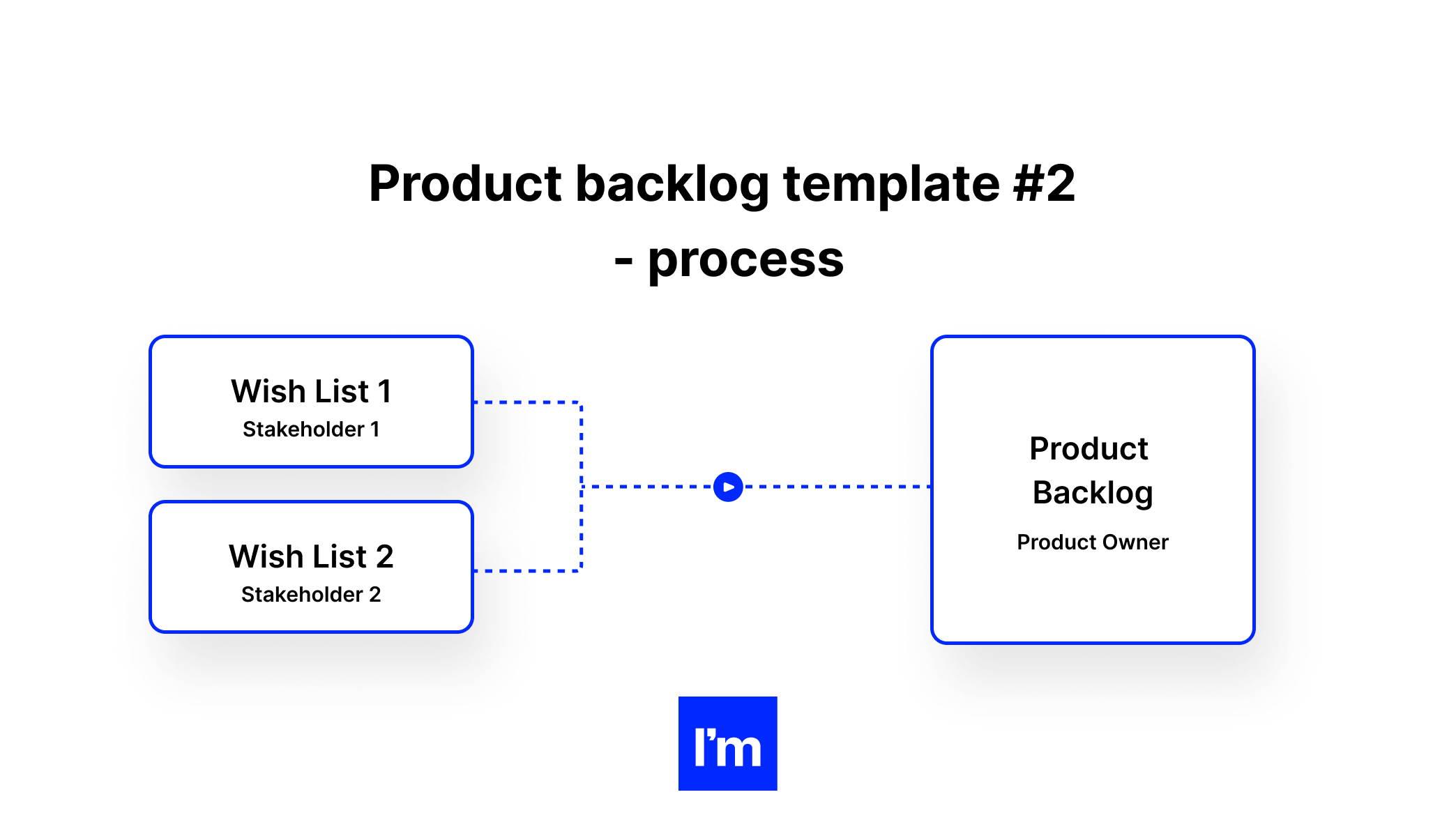
The second way for the product owner to structure a backlog, common in lean organizations, is the workflows and processes needed to get an idea through the pipeline to release. Simply put, you may have certain processes for managing the product life cycle that you want to reflect in the product backlog.
When we structure in this way, several things can happen:
The workflow can be optimized
When we structure the backlog into high-level process steps, we can closely monitor the flow between each step and find ways to optimize it.
The amount of backlog may be limited
A process-oriented backlog is especially useful in situations where the product owner is good at saying no and wants to keep as few items in their backlog as possible.
Interested parties can participate
With this setup, stakeholders can easily contribute by having their own specific place in the backlog, sometimes referred to as a "wish list". If accepted, their ideas go into the product backlog and start moving down the pipeline.
User stories can lose context
As in the first example, user stories in a process-driven backlog can lose critical context as to where they fit into the big picture.
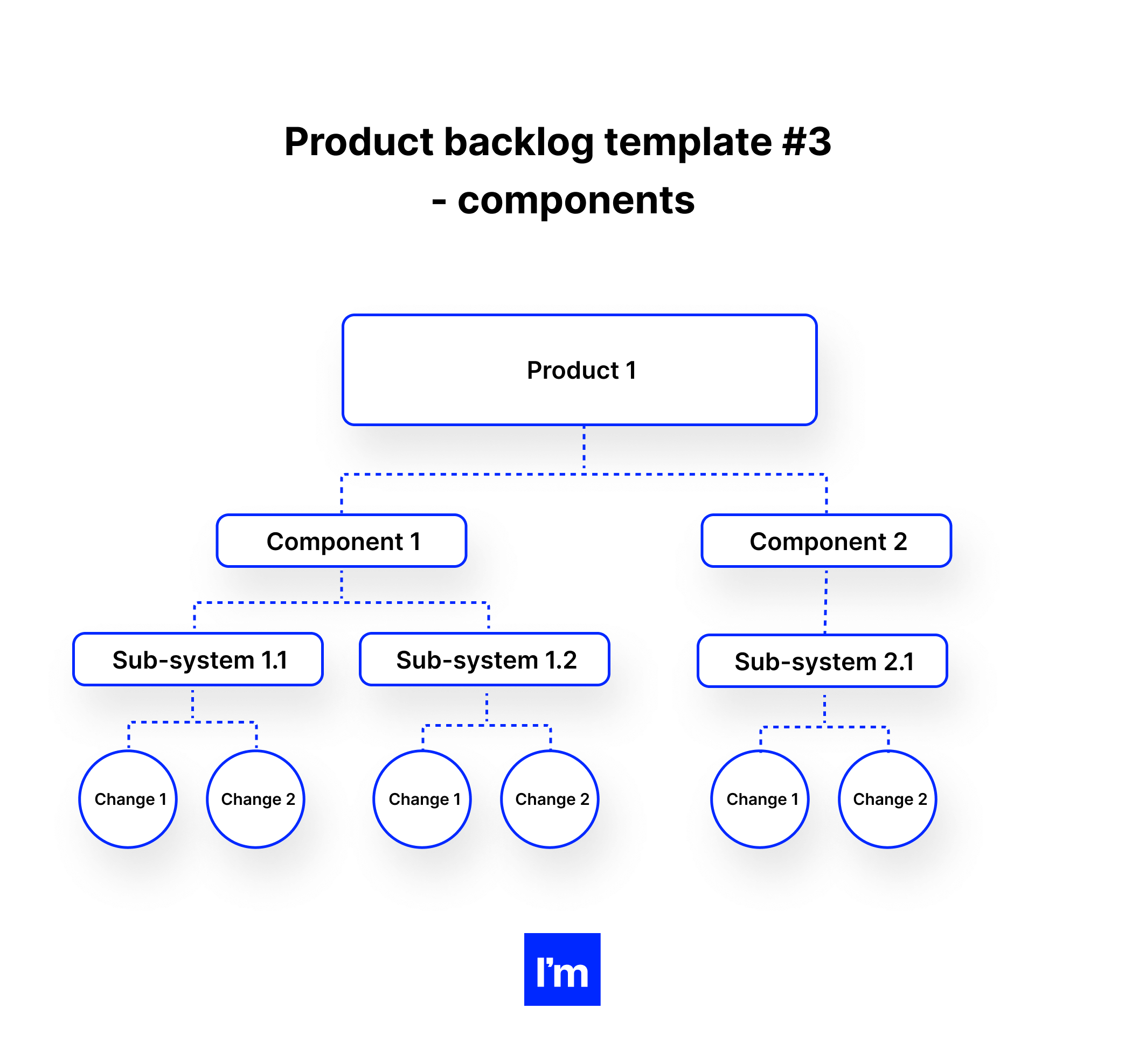
Instead of an organization or process, you can organize your backlog around a product and create a breakdown structure for product components or deliverables under development.
When we structure in this way, several things can happen:
Product modularity can be supported
If your organization sells many parts or components of a product (rather than the entire product) to third-party vendors, the component organization can help you understand order or vendor progress.
Traditional planning methods can succeed
If you're using traditional scheduling methods, this framework makes it easier to plan and transition to a Gantt chart, which in turn can help you understand what leads to an entire component being ready for production.
Overhead costs can be high
This structure requires careful thought and planning ahead of time before anything is built. Depending on what you are developing, you can create a lot of overhead, especially if you are creating a backlog for an unprecedented product.
Dependency management can be difficult
When changes occur (which often happens these days), resolving the resulting dependencies makes it difficult to provide a useful feature without a lot of work and hassle.
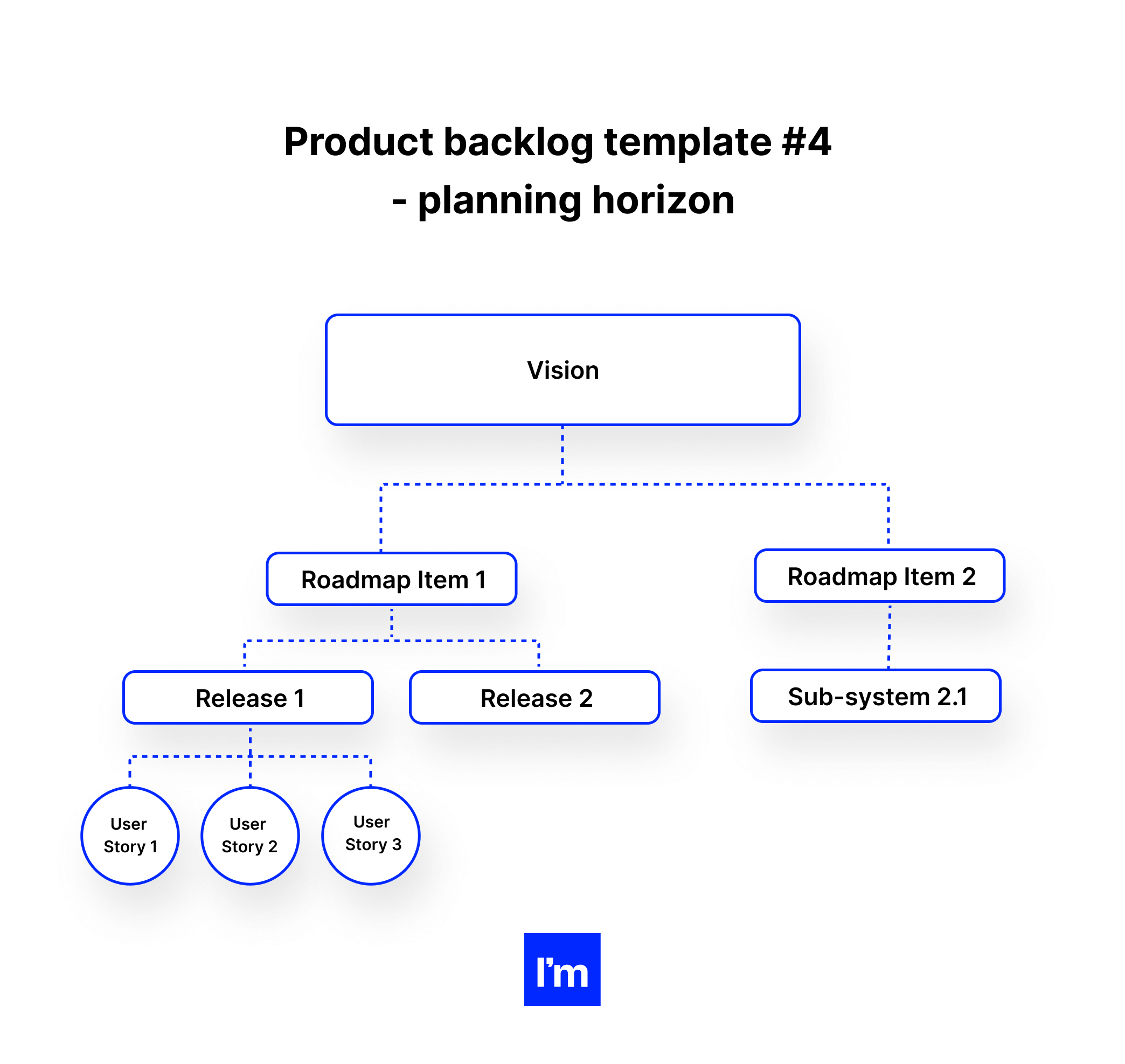
The fourth way to structure the backlog is to use a planning horizon. The planning horizon, a five-step concept common to many product development organizations, starts high in the vision and descends many levels into day-to-day commitment.
- Product vision
- Product roadmap
- Release plan
- Iteration plan
- Daily commitment
A planning horizon organization can do the following:
Stakeholders can easily understand this
Remember, as we mentioned at the beginning, many stakeholders just want to know "when their job is done." Structuring the planning horizon helps stakeholders understand exactly when and what to expect.
Team obligations can be difficult to distinguish
The obvious problem with this structure is finding a useful and valuable way to separate this plan from team commitments, such as in a sprint.
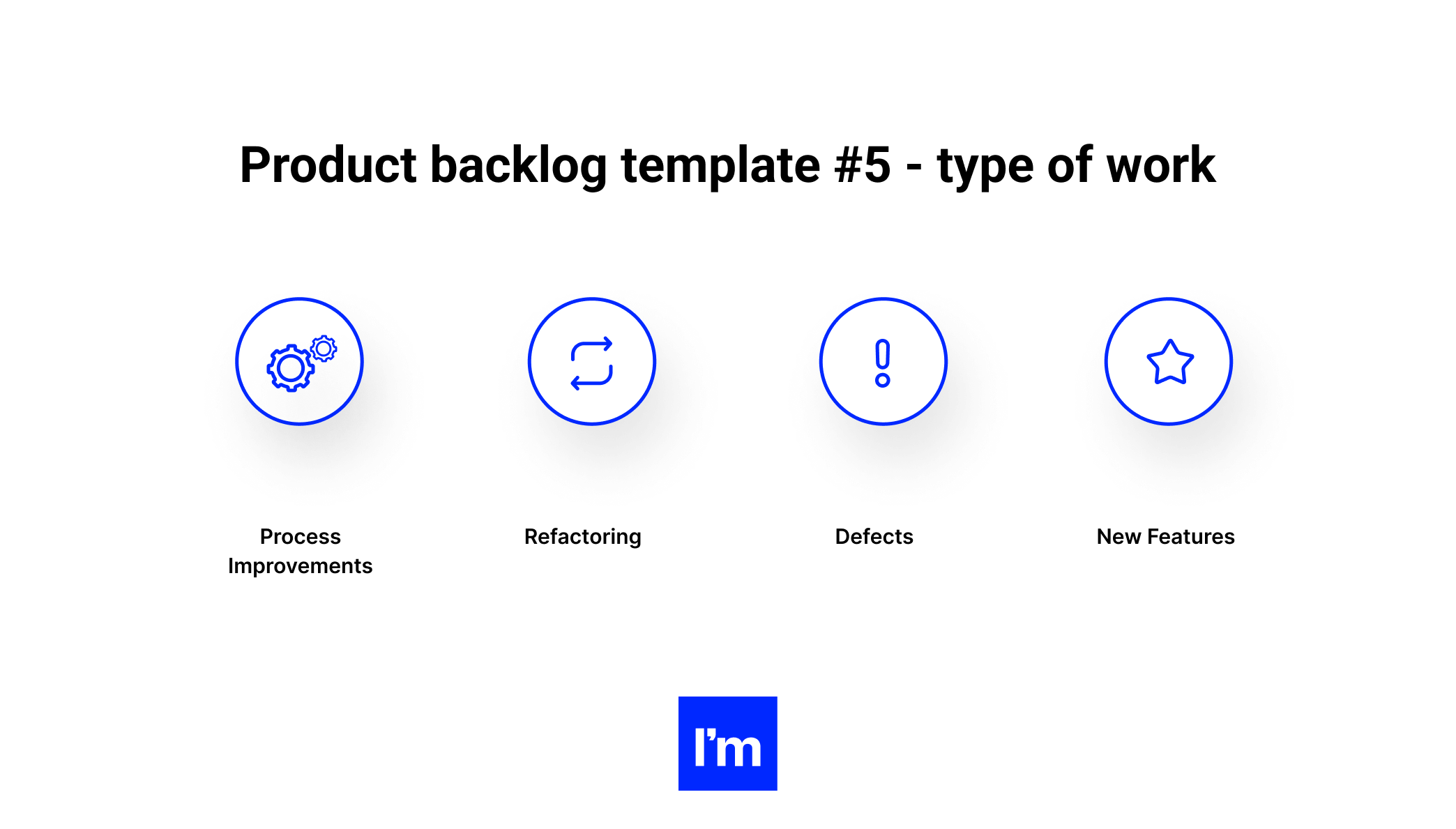
A lot more work goes into a product than into the features it provides — bug fixes, refactorings, process improvements. A product backlog organized around these different types of work can help us shift our focus from a brilliant feature to other types of work needed to deliver value to our customers.
Here's what can happen when we structure by type of work:
Teams can evenly distribute their attention
With this structure, it's easier to tell teams to pick at least one item from each bucket of different work items. It is also easier to understand the distribution of work between different types.
Service classes can be simplified
This approach is also useful when using different service classes (and a single column attribute is not enough).
The value can become invisible
Organizing by type of work can be problematic if it means we forget about value, which should always come first. For this reason, we recommend including the work type in one column rather than allowing it to dominate the backlog structure.
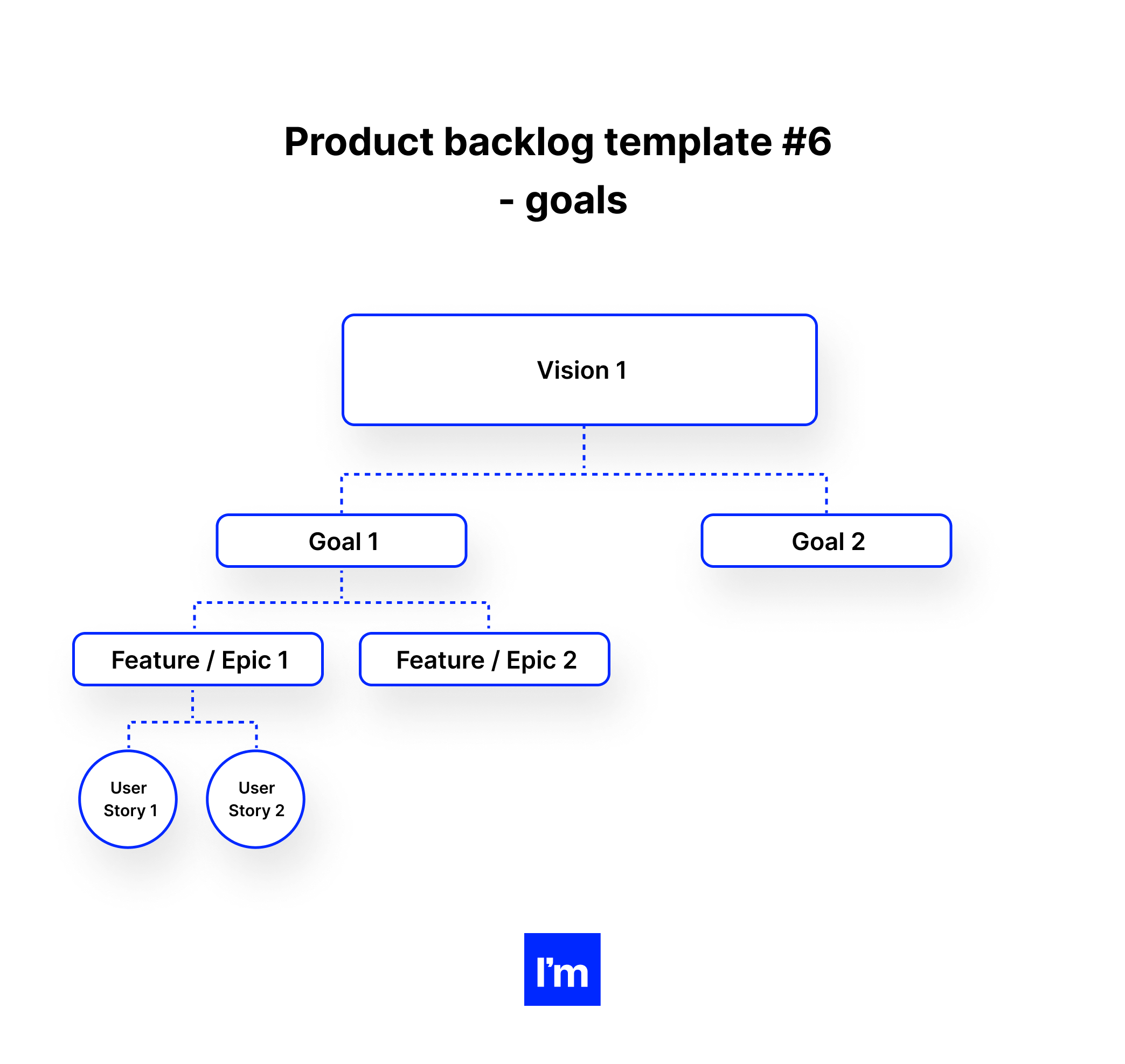
With the caveat that there are many ways to structure a backlog, we will now look at the structure that we recommend the most: a purposeful backlog. In which we strive to reflect the goals and vision of the product, broken down into subfunctions.
Here's what can happen when we structure around goals:
Teams can focus on business value
The advantage of this structure is that it almost guarantees that teams:
- Focus on items with high business value;
- Improve the right things in the product.
Work can be more measurable and accountable
By defining these high-level goals (also called "business epics''), we can create quick, measurable feedback loops to see if we're doing the right thing or not. In addition, we take responsibility for achieving our goals, which we see every day in the prepared doc.
Tips for prioritizing the product backlog for successful sprint planning
Define your goals
Once you have a good understanding of who your users are and what problems they face, you can start thinking about what your team can do to help. If your organization already has an agreed vision for the future, this can help you define a set of goals.
Talk to your stakeholders such as organization leaders, project sponsors, and investors. They will likely have business goals in mind for the future of your product, but those aren't the only ones that matter.
Roadmaps and Requirements
Start with the two R's: the roadmap and the requirements. These two elements are at the heart of every product backlog. The roadmap is the foundation for how the project will take shape. Requirements are a list of backlog items that development teams need to complete in order to complete the project. Write down your roadmap and requirements so you can start building around them.
Let's say your development team is building an app that shows runners how safe a road is. Since this application is the highest priority for the company, it is the first and most important item on the roadmap. The team must first collect road safety data. You would list data collection as a requirement.
Meet expectations
To know if the backlog is going to lead development in the right direction, you need to know who wants what from it.
- As a member of the team, I want to know which user stories to work on next and understand how my work fits into the overall matrix.
- As a product owner, I want to see features evolve so I can adjust and refine priorities with the team.
- As a project leader, I want to see how the product develops and how the overall progress is made.
- As a stakeholder, I want to know when my product will be ready.
Sorting
To scale backlog, group tasks into short-term and long-term. The product owner should drill down on short-term tasks before sorting them: make sure development teams and design teams are on the same wavelength, and refine development estimates. While long-term goals may remain vague, they should have a rough description and timeline.
Share your backlog and collect feedback
Having reached this step, you have created the initial backlog. However, your work is not yet complete. The product backlog may be missing some key considerations, such as commercial implications and external constraints. Be sure to present your backlog to key stakeholders so their feedback is captured in advance.
Regular team reviews
Once you've created your product backlog, it's time to review it. Product owners should periodically clean up the backlog before each planning meeting. In particular, it helps to double-check prioritization and make sure developers implement feedback.
Summing up
That's it! Six product backlog templates for structuring an agile backlog. And of course, as with any occupation, a combination of these project management approaches is often used to achieve the best results, rather than just one.
The key is to have a systematic project management approach to how you create and structure your backlog - especially in large-scale contexts - and improve based on that. The results will follow.
Want to know what else can speed up the arrival of the results? Teaming up with seasoned software engineers and Scrum masters.
Indeed, hiring remote software devs is the best post-covid strategy. Ideamotive has been around for a while and knows exactly how IT outsourcing can benefit modern projects.
Our tech talent marketplace is always ready to supplement your dev team with the required talent:
Haven’t developed your digital product development strategy yet? Turn to vetted specialists with years of experience behind.
Top tech talent matched with your industry, technology, and company culture will help you build, track and manage your product backlog more efficiently!
Contact us for more info!








